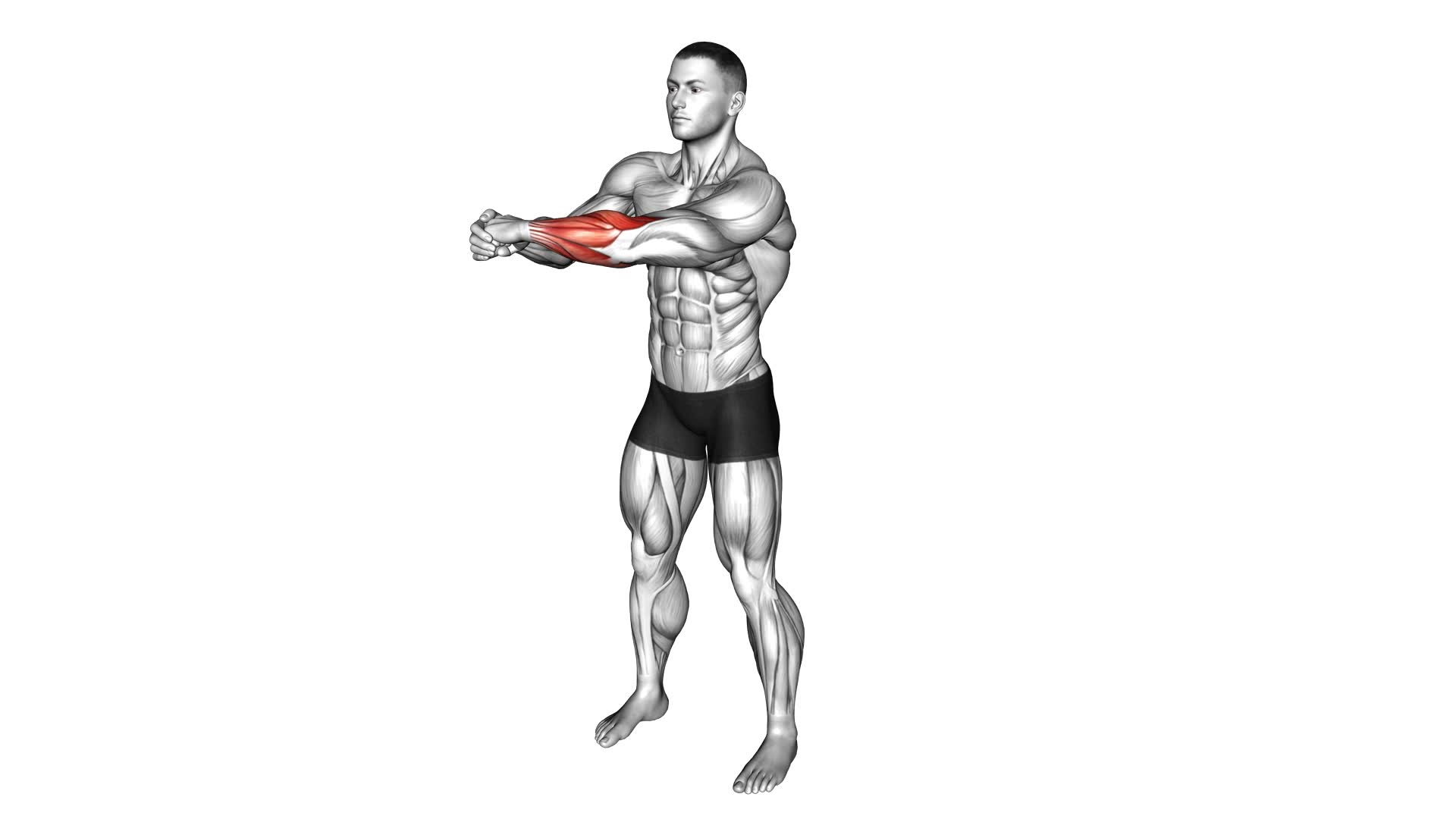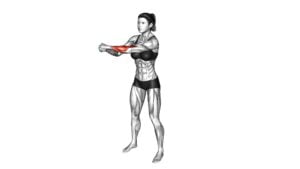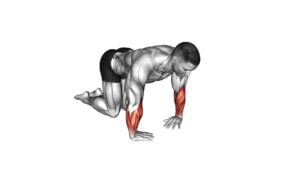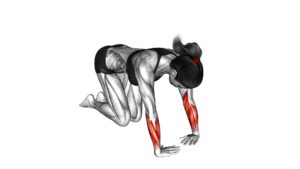Side Wrist Pull Stretch – Video Exercise Guide & Tips

Are you looking for an effective wrist stretch to improve flexibility and prevent injury? Look no further than the side wrist pull stretch!
Watch This Exercise Video
In this video exercise guide, we'll show you the proper technique and provide helpful tips to enhance its effectiveness. Avoid common mistakes and discover modifications and variations to suit your needs.
Prioritize safety and learn how to maximize the benefits of the side wrist pull stretch. Let's get started!
Key Takeaways
- The side wrist pull stretch improves wrist flexibility and mobility.
- It targets the muscles and tendons in the wrist, increasing range of motion and function.
- It is beneficial for activities with repetitive wrist movements, promoting healing and reducing the risk of injury.
- Proper technique and hand positioning, along with avoiding excessive force, are important for maximizing the effectiveness of the stretch.
Benefits of the Side Wrist Pull Stretch
One major benefit of the Side Wrist Pull Stretch is that it helps improve wrist flexibility and mobility. This stretching technique focuses on stretching the muscles and tendons in the wrist, allowing for greater range of motion and improved function. By incorporating this exercise into your routine, you can effectively target the muscles and ligaments in the wrist, promoting increased flexibility and mobility.
Wrist flexibility exercises, such as the Side Wrist Pull Stretch, can be particularly beneficial for individuals who engage in activities that require repetitive wrist movements, such as typing, playing musical instruments, or participating in sports like tennis or golf. These activities can often lead to tightness and stiffness in the wrist, limiting its range of motion and potentially leading to pain or discomfort.
The Side Wrist Pull Stretch specifically targets the muscles and tendons on the side of the wrist, helping to stretch and lengthen them. This not only improves flexibility, but also helps to increase blood flow to the area, promoting healing and reducing the risk of injury. By regularly incorporating this stretch into your routine, you can keep your wrists flexible and mobile, allowing for improved performance and reduced risk of strain or injury.
Proper Technique for the Side Wrist Pull Stretch
To perform the side wrist pull stretch with proper technique, it's important to pay attention to your hand position. Keep your fingers together and extend your arm fully to ensure a thorough stretch.
Additionally, it's recommended to hold the stretch for 20-30 seconds on each side. Avoid common mistakes such as pulling too hard or jerking your wrist, as this can lead to injury.
Hand Position Importance
To properly perform the side wrist pull stretch, it's important for you to maintain proper hand positioning. The way you grip your hand during this exercise will determine the effectiveness of the stretch and ensure proper wrist flexibility. Here are five key points to remember about hand position for the side wrist pull stretch:
- Place your hand palm-down on a flat surface.
- Spread your fingers wide and press them firmly into the ground.
- Keep your wrist in line with your forearm, creating a straight line from your fingertips to your elbow.
- Avoid bending your wrist or allowing it to collapse sideways.
- Engage your forearm muscles to maintain stability and control during the stretch.
Following these hand positioning guidelines will help you maximize the benefits of the side wrist pull stretch and prevent any unnecessary strain or injury.
Stretch Duration Guidelines
How long should you hold the side wrist pull stretch for maximum benefit?
The duration of the side wrist pull stretch is an important factor to consider in order to achieve the desired results. It's recommended to hold the stretch for about 15 to 30 seconds per repetition. This allows enough time for the muscles and tendons in the wrist to gradually lengthen and increase flexibility.
Holding the stretch for too short of a duration may not effectively target the muscles, while holding it for too long could lead to excessive strain or overstretching.
To enhance the stretch intensity and maximize the benefits, it's advisable to perform proper warm-up exercises before starting the side wrist pull stretch. These warm-up exercises help prepare the muscles and joints, reducing the risk of injury and improving the effectiveness of the stretch.
Common Mistakes to Avoid
Avoiding common mistakes is crucial for performing the side wrist pull stretch with proper technique. Here are some key things to keep in mind to ensure injury prevention and maintain proper form:
- Maintain a neutral wrist position throughout the stretch to avoid excessive strain on the joint.
- Avoid pulling or jerking the wrist too forcefully, as this can lead to muscle strain or injury.
- Engage your core muscles and keep your body stable to prevent unnecessary movement or compensation.
- Don't overstretch the wrist by pulling it beyond its comfortable range of motion.
- Gradually increase the intensity of the stretch over time, rather than pushing too hard or too quickly.
By following these guidelines, you can reduce the risk of injury and maximize the benefits of the side wrist pull stretch.
Now let's move on to the next section and discuss the common mistakes to avoid during this exercise.
Common Mistakes to Avoid During the Side Wrist Pull Stretch
To ensure proper hand positioning during the side wrist pull stretch, make sure your fingers are spread wide and your palms are facing up.
Avoid the common mistake of applying excessive force while pulling your wrist to the side, as this can lead to strain or injury.
Remember to maintain a gentle and controlled movement throughout the stretch to maximize its effectiveness and minimize the risk of harm.
Proper Hand Positioning
Make sure your hand placement is correct during the side wrist pull stretch to avoid common mistakes. Proper hand positioning is crucial for performing this exercise effectively and preventing injury. Here are some key points to remember:
- Align your hand with your forearm: Keep your hand in line with your forearm to maintain proper alignment and reduce strain on the wrist joint.
- Spread your fingers: Spread your fingers wide to create a stable base of support and engage the muscles in your hand and forearm.
- Avoid gripping too tightly: Maintain a relaxed grip to prevent unnecessary tension in your hand and forearm muscles.
- Keep your wrist neutral: Avoid excessive flexion or extension of the wrist. Maintain a neutral position to protect the joint.
- Maintain a straight line from elbow to fingertips: Ensure that your forearm, wrist, and hand form a straight line to maximize the effectiveness of the stretch.
Avoiding Excessive Force
Maintain proper hand positioning to avoid applying excessive force during the side wrist pull stretch. When performing exercises to strengthen wrists or wrist stretches for flexibility, it's crucial to avoid putting too much pressure on the wrists.
One common mistake is pulling the wrist too forcefully during the stretch, which can lead to unnecessary strain and potential injury. Instead, focus on gradual and controlled movements, allowing the stretch to be felt without any sharp or intense pain.
Remember to listen to your body and adjust the intensity accordingly. By avoiding excessive force and practicing proper technique, you can effectively stretch and strengthen your wrists while minimizing the risk of injury.
Tips to Enhance the Effectiveness of the Side Wrist Pull Stretch
To maximize the effectiveness of the Side Wrist Pull Stretch, ensure that you perform the exercise with controlled and deliberate movements. This won't only enhance flexibility but also help prevent wrist injuries. Here are five tips to enhance the effectiveness of this stretch:
- Warm-up: Before starting the Side Wrist Pull Stretch, it's crucial to warm up your wrists and hands. Perform gentle wrist rotations and flexion/extension exercises to increase blood flow and loosen up the muscles.
- Proper positioning: Position your arm and hand correctly before beginning the stretch. Make sure your elbow is straight and your palm is facing up. This alignment will target the muscles and tendons in the wrist effectively.
- Gradual stretch: Start with a gentle pull and gradually increase the intensity of the stretch. Avoid sudden jerking or excessive force, as it can strain the wrist joint and lead to injuries.
- Hold and breathe: Hold the stretch for 15 to 30 seconds while maintaining a relaxed breathing pattern. This will allow the muscles to elongate and increase their flexibility.
- Repeat on both sides: Perform the Side Wrist Pull Stretch on both wrists to ensure balanced flexibility and prevent muscle imbalances.
Modifications and Variations of the Side Wrist Pull Stretch
Enhance your Side Wrist Pull Stretch with these modifications and variations.
By making some modifications to the traditional Side Wrist Pull Stretch, you can target different muscles and increase the effectiveness of the exercise.
One modification you can try is using a resistance band. Instead of using your opposite hand to pull your wrist, loop a resistance band around your hand and anchor it to a stable object. This will provide added resistance and challenge your muscles further.
Another modification is to perform the stretch on an incline. Place your forearm on an inclined surface such as a bench or table, with your palm facing down. This variation will engage your muscles in a different way and intensify the stretch.
Additionally, you can try variations of the Side Wrist Pull Stretch by changing the grip. Instead of pulling the wrist with your fingers, use your knuckles or the back of your hand to apply the pressure. These variations will target different areas of the wrist and forearm, providing a more well-rounded workout.
Remember to start with light resistance and gradually increase as you become more comfortable with the modifications and variations.
Precautions and Safety Considerations for the Side Wrist Pull Stretch
Ensure proper form and technique when performing the Side Wrist Pull Stretch to prevent injury and maximize its benefits. Here are some precautions and safety considerations to keep in mind:
- Warm-up: Always warm up your wrists and forearms before attempting any stretching exercise. This helps increase blood flow and reduces the risk of injury.
- Gradual progression: Start with gentle pulls and gradually increase the intensity over time. Avoid sudden or forceful movements that could strain your wrists.
- Listen to your body: Pay attention to any pain or discomfort during the stretch. If you experience sharp or intense pain, stop immediately and consult a healthcare professional.
- Avoid overstretching: Be mindful not to push your wrists beyond their limits. Overstretching can lead to injury and may hinder your progress.
- Modify or try alternative stretches: If you have pre-existing wrist or hand injuries, it's important to modify the exercise or consult a physical therapist for alternative stretches that are safe for your condition.
By following these precautions and safety considerations, you can reduce the risk of injuries and safely perform the Side Wrist Pull Stretch.
Frequently Asked Questions
Can the Side Wrist Pull Stretch Help With Carpal Tunnel Syndrome?
Yes, the side wrist pull stretch can be an effective alternative treatment for carpal tunnel syndrome. Stretching plays a crucial role in preventing and relieving symptoms of this condition.
By performing this stretch, you can target the muscles and tendons in the wrist and forearm, promoting flexibility and reducing pressure on the median nerve.
Incorporating stretching exercises into your routine can help alleviate pain and discomfort associated with carpal tunnel syndrome.
Should I Perform the Side Wrist Pull Stretch Before or After My Workout?
To maximize the benefits of the side wrist pull stretch, it's important to know when to perform it.
Should you do it before or after your workout? Well, the answer depends on your goals.
If you want to warm up your wrists and improve flexibility before exercise, it's best to do the stretch before your workout.
However, if you want to cool down and release tension in your wrists after your workout, then perform the stretch afterwards.
Proper technique for the side wrist pull stretch is crucial for optimal results.
Can I Do the Side Wrist Pull Stretch if I Have a Wrist Injury?
If you have a wrist injury, it's important to prioritize wrist injury management and avoid exercises that may further aggravate it.
The side wrist pull stretch may not be suitable for you in this case. However, there are alternative stretches for wrist pain that you can try. These stretches can help relieve discomfort and promote healing.
It's always best to consult with a healthcare professional or a qualified trainer for personalized advice and guidance.
How Long Should I Hold the Stretch for Maximum Benefit?
To maximize the benefits of the side wrist pull stretch, it's important to consider the length of the stretch and the recommended stretching duration.
The length of the stretch refers to how far you pull your wrist to the side.
The recommended stretching duration is the amount of time you should hold the stretch.
Can the Side Wrist Pull Stretch Improve Grip Strength?
Improving your grip strength is essential for athletic performance.
While the side wrist pull stretch may help increase flexibility and prevent injuries, it may not directly improve grip strength.
To enhance your grip, focus on exercises like deadlifts, farmer's walks, and kettlebell swings.
These exercises target the muscles responsible for grip strength and can lead to significant improvements.
Incorporate them into your training routine for maximum benefit and enhanced athletic performance.
Conclusion
In conclusion, the Side Wrist Pull Stretch is a beneficial exercise for improving wrist flexibility and strength. By following proper technique and avoiding common mistakes, you can maximize the effectiveness of this stretch.
Additionally, incorporating modifications and variations can help target different muscles and enhance the stretch. It's important to take precautions and consider safety measures while performing this exercise to prevent any potential injuries.

Author
Years ago, the spark of my life’s passion ignited in my mind the moment I stepped into the local gym for the first time. The inaugural bead of perspiration, the initial endeavor, the very first surge of endorphins, and a sense of pride that washed over me post-workout marked the beginning of my deep-seated interest in strength sports, fitness, and sports nutrition. This very curiosity blossomed rapidly into a profound fascination, propelling me to earn a Master’s degree in Physical Education from the Academy of Physical Education in Krakow, followed by a Sports Manager diploma from the Jagiellonian University. My journey of growth led me to gain more specialized qualifications, such as being a certified personal trainer with a focus on sports dietetics, a lifeguard, and an instructor for wellness and corrective gymnastics. Theoretical knowledge paired seamlessly with practical experience, reinforcing my belief that the transformation of individuals under my guidance was also a reflection of my personal growth. This belief holds true even today. Each day, I strive to push the boundaries and explore new realms. These realms gently elevate me to greater heights. The unique combination of passion for my field and the continuous quest for growth fuels my drive to break new ground.



